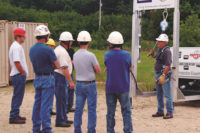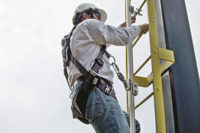
At last year’s National Safety Council Congress and Expo, OSHA presenters noted that fall protection was the agency’s second-most cited violation category. That’s no surprise — fall protection consistently ranks among OSHA’s highest number of inspections and total fines. In one high-profile case last year, OSHA fined a Pennsylvania company more than $500,000 following a roofer’s fatal fall.
Justification for investing in a strong fall protection program goes much deeper than avoiding six-figure penalties. The Bureau of Labor Statistics (BLS) recorded well more than 600 fall-related fatalities in 2009, and falls are perennially cited as the leading cause of worker death in the construction industry.
Also, falls represent an enormous business cost. BLS logged more than 212,000 incident cases involving falls in private industry in 2009. With a high percentage of falls resulting in serious injury, that translates to significant lost time, workers’ compensation, litigation, and related costs. Falls also impact morale, productivity and corporate reputation — and can be a deciding factor in job bids.
High stakes
With so much at stake, many companies already push their fall protection programs beyond OSHA compliance, including voluntary adherence to the more stringent ANSI Z359 standards. Combined with improvements in safety equipment and training, fatal falls have decreased nationwide in the past two years as a result. The power of stronger fall protection programs is particularly evident in the roofing industry. The National Roofing Contractors Association (NRCA) has partnered with insurers and vendors that serve the industry to promote fall protection best practices, accountability and new equipment. Between 2005 and 2010, ongoing training seminars, webinars, and other efforts helped decrease industry falls by a remarkable 69 percent.But continuous improvement is a must. “Complacency can’t be an option — it has to be a living program,” says Gary Clevenger, CSP, CRIS, and national risk control director – construction for CNA, one of the nation’s largest commercial property and casualty insurers. “What worked two years ago may not be the best approach anymore.”
Where can you improve your fall protection efforts? Staying updated on tools, equipment or structural solutions is clearly important but don’t forget that all of those still depend on people using them properly, identifying and managing hazards, and knowing and employing the best safety practices. Strengthening your fall protection program means strengthening your training.
Hands-on, classroom or eLearning?
OSHA and ANSI prescribe a combination of informational and hands-on training. ANSI Z359.2 is a particularly good resource for defining overall training needs, offering details across six levels of competency that employees should be trained in based on the functions they perform.Make no mistake, when it comes to fall protection systems and equipment, OSHA (and common sense) require hands-on learning that approximates actual work conditions. If we’re talking about a harness for example, there is no substitute for strapping into it, connecting to an anchor, experiencing how it feels, and seeing firsthand what needs to be inspected before use.
That said, eLearning, or computer-based training, can be valuable in conveying information that has traditionally been handled through classroom training or “toolbox talks.” In fact, one advantage of using eLearning where it is equally or more effective than lectures is that it gives instructors more time to focus on training and demonstrations that should (or must) be done in person.
eLearning can strengthen the effectiveness of your program, ensuring greater consistency and a more interactive, engaging learning experience that improves retention. Past concerns about workers resisting computers have dissipated as the Internet, video gaming, Smartphones, and similar technology have become mainstream. For many younger workers, computer-based instruction is not only familiar, it’s their preferred learning mode.
eLearning solutions simplify scheduling, testing, tracking and reporting. Comprehensive web-based systems add tools for incident investigation, observations and assessments, claims management and more. Since vendors update solutions when regulations or best practices change, your training stays current and you don’t lose time revising your materials.
Governance and transparency
More companies today are improving governance and transparency. Another benefit of web-based solutions is the ease and accessibility of documentation. Whether you’re responding to an accident, an OSHA inspection, or just need to document training for a job bid, accurate, up-to-date records are always just a few mouse clicks away.Exactly how eLearning fits into your fall protection training will depend on work conditions, culture and other factors. For example, University Mechanical & Engineering Contractors, Inc. (UMEC) Director of Loss Control Dominic Caminiti says, “We rotate multiple supervisors to handle new hire training, so projecting modules on a big screen in our classes helps standardize training regardless of who delivers it.”
That’s one way eLearning has saved UMEC time and money, while contributing to a program that is approaching five million man-hours without a losttime injury. “At many sites, we have a 52-inch monitor for Building Information Modeling and Computer- Aided Design that often sat idle for hours,” he adds. “Now, we’ll put an eLearning module on it for on-site training. For remote projects, I have access to a webbased system that allows me to assign training, and be notified when it’s completed, by email. Our program emphasizes in-person and hands-on training, and that won’t change. But anywhere that eLearning can help us do that better, we’ll use it.”
Strengthening protection -- and profits
There is a strong business case for being a fall protection leader and adapting state-of-the-art equipment, investing in training and employing best practices. “You’re going to reduce claim costs, which also helps you bid lower and tout an outstanding safety record to win more jobs,” Clevenger points out. “You’ll lower your OSHA recordables, and perform better in other areas that impact insurance modification ratings, which means you will get more competitive rates from more insurers. You’ll probably also improve other areas of safety because for companies that work at heights, fall protection is often the heart of the overall safety culture.”According to Caminiti, UMEC’s experience proves that strong fall protection programs and a strong safety culture are a solid business investment. “After our last fall, UMEC took a zero tolerance approach to fall protection,” he says. “It’s paid off in nearly six years without a lost-time injury, three with zero reportable injuries — and the three most profitable years in our 80-year history. Top employees want to work for us and top clients want us to work on their projects, even if we’re not the lowest bidder.”
The business case should not overshadow the fundamentally moral responsibility to do everything you can to protect employees working at heights. But when you continually evolve your program to keep up with the best available equipment, training and safety practices, you prove protecting lives is also good business.

